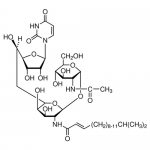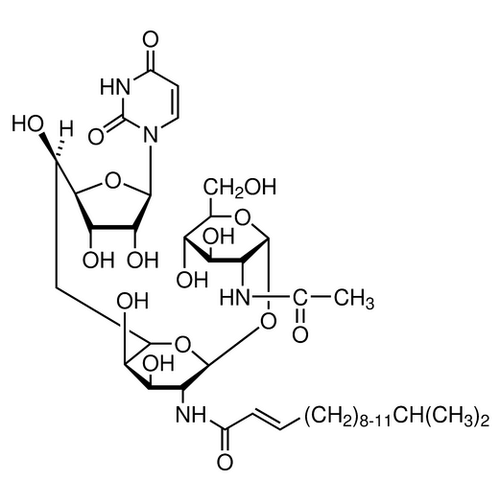| Product Name | Tunicamycin |
| Description |
Autophagy inducer |
| Purity | >98% (HPLC) as a mixture of tunicamycin A, B, C and D |
| CAS No. | 11089-65-9 |
| Molecular Formula | C39H64N4O16 |
| Molecular Weight | 844.95 |
| Field of Use | Not for use in humans. Not for use in diagnostics or therapeutics. For in vitro research use only. |
Properties
| Storage Temperature | -20ºC |
| Shipping Temperature | Shipped Ambient |
| Product Type | Inducer |
| Solubility | Soluble in DMSO (>10 mg/ml) or ethanol (5 mg/ml; warm). |
| Source | Isolated from Streptomyces lysosuperficus |
| Appearance | White solid. |
| SMILES | [C@@H]2(O[C@H](O[C@H]1O[C@@H]([C@@H](O)[C@H](O)[C@H]1NC(=O)C)CO)[C@H](NC(=O)C=CCC(C)C)[C@@H](O)[C@H]2O)CC(O)[C@H]4O[C@@H |
| Safety Phrases |
Classification: D1A- Very Toxic Material Causing Immediate and Serious Toxic Effects, Highly toxic by ingestion, D2A- Very Toxic Material Causing Other Toxic Effects, Teratogen- Reproductive hazard Safety Phrases: S22 - Do not breathe dust. S24/25 - Avoid contact with skin and eyes. S36/37/39 - Wear suitable protective clothing, gloves and eye/face protection. Hazard statements: H300- Fatal if swallowed. Precautionary statements: P264- Wash hands thoroughly after handling. P301 + P310- IF SWALLOWED: Immediately call a POISON CENTER or doctor/ physician. |
| Cite This Product | Tunicamycin (StressMarq Biosciences Inc., Victoria BC CANADA, Catalog # SIH-397) |
Biological Description
| Alternative Names | Tunicamycin from Streptomyces sp. |
| Research Areas | Autophagy, Cancer |
| Scientific Background | Tunicamycin is an antibiotic that inhibits N-linked glycosylation by blocking the formation of N-acetylglucosamine-lipid intermediates. This disruption leads to ER stress and activation of the unfolded protein response (UPR). In neuroscience, Tunicamycin is used to model ER stress and study its effects on neuronal survival, protein folding, and neuroinflammation. It is particularly relevant in Alzheimer’s and Parkinson’s disease research, where ER dysfunction and protein misfolding are central pathological features. |
| References |
1. Unal E.S., et al. (2008) Biochim Biophys Acta. 1778(6): 1407-14. 2. Ding W.X., et al. (2007) J Biol Chem. 282(7): 4702-10. 3. Ishii S., et al. (1987) J Neurochem. 49(5): 1606-12. 4. Zhang J., et al. (2013) J Surg Res. 183(2): 929-35. |



Reviews
There are no reviews yet.